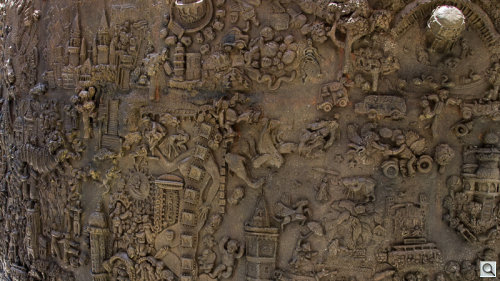Photo Corners headlinesarchivemikepasini.com
![]()
A S C R A P B O O K O F S O L U T I O N S F O R T H E P H O T O G R A P H E R
![]()
Enhancing the enjoyment of taking pictures with news that matters, features that entertain and images that delight. Published frequently.
Friday Slide Show: Asawa's San Francisco Fountain




17 June 2016
Rome has the Trevi, Barcelona has the Montjuic, Vegas has the Bellagio but we're staying home with Ruth Asawa's San Francisco Fountain. (Try singing that, Tony.) It was a bright, sunny day when we walked around the sculpture to take a fanciful tour of the city in nothing but our shoes.
Ruth Asawa was born the fourth of seven children on Jan. 24, 1926 in Norwalk, Calif. to Japanese immigrant parents, who were themselves truck farmers.
Even though she was an American citizen, she was interned at the Santa Anita Race Track, living in the horse stables for six months in 1942 before being transferred by train to the Rohwer Relocation Center in Arkansas.
About 62 percent of the nearly 120,000 people of Japanese ancestry incarcerated under Executive Order 9066 of Feb. 19, 1942, were U.S. citizens. Germans and Italians were also relocated under the act.
Asawa she lived in a tar-paper barrack at the camp for 18 months graduating from high school there. A Quaker organization gave her a scholarship to attend college in Wisconsin, where she studied to be an art teacher at Milwaukee State Teachers College.
Unable to complete her student teaching requirement "due to hostility against the Japanese," she enrolled to Black Mountain College in North Carolina where she studied art for three years and met her future husband Albert Lanier.
She followed Lanier to San Francisco, where they married and made the city their home. They had six children in nine years as Asawa became recognized for her looped wire sculpture, 15 of which are permanently installed in the de Young Museum's tower lobby.
She was encouraged by other local artists she befriended, including the photographer Imogene Cunningham, who advised her to use her maiden name.
As her art developed so did her activism. She cofounded the Alavarado School Arts Workshop to bring artists into the public schools and became a member of the San Francisco Arts Commission, the California Arts Council, the National Endowment for the Arts and a trustee of the Fine Arts Museums of San Francisco.
Among her public works is the nursing mermaid sculpture in Ghirardelli Square and the Japanese American Internment Memorial in San Jose.
In 2010 the public high school for the arts that she fought for was named after her.
She passed away in 2013 at the age of 86.
For the San Francisco Fountain, she used baker's clay, casting the dried-out, finished clay designs in bronze. Why baker's clay? So over 100 children and various visitors could help sculpt the fountain.
"When I work on big projects, such as a fountain," she explained, "I like to include people who haven't yet developed their creative side -- people yearning to let their creativity out. I like designing projects that make people feel safe, not afraid to get involved."
It was commissioned in 1970 and completed two years later. There are 41 26x32-inch bronzed plaques circling the 14-foot diameter of the fountain.
The scenes depict familiar San Francisco locations with everything south of Union Square to the left and everything north to the right. The ocean is on top and the bay on the bottom of the fountain.
We often meet tourists who, to get a feel for the city, take one of those half-day bus tours that runs you around town. But we're not sure a leisurely stroll around Asawa's fountain before lunch downtown (say, at Sam's Grill) isn't a better idea.
Or you could just get booth at Sam's, order a dry martini to go with the fried zucchini and scroll through our slide show.
